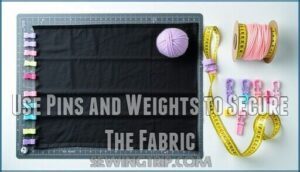This site is supported by our readers. We may earn a commission, at no cost to you, if you purchase through links.

First, use sharp scissors or a rotary cutter for clean edges—this fabric doesn’t forgive mistakes.
A teflon-coated needle helps glide through the thick material, and a longer stitch length prevents puckering.
Skip pins; they leave holes, instead, try fabric weights or clips to manage the fabric.
To avoid funny hangs, carefully line up the curtains and blackout fabric, and manage the fabric’s weight—draping it awkwardly can cause issues.
Needle getting dull? Swap it regularly to avoid skipped stitches, with these easy tweaks, your blackout curtain project will shine—or rather, block shine with clean edges.
Table Of Contents
- Key Takeaways
- Difficulty Cutting and Sewing Blackout Lining
- Tips for Successful Sewing
- Challenges With Handling Thick and Coated Blackout Lining
- Common Stitch Quality Problems
- Regularly Change Your Needle
- Select The Correct Needle Type
- Use The Appropriate Bobbins
- Opt for Good Quality Threads
- Properly Maintain Your Sewing Machine
- Frequently Asked Questions (FAQs)
- Conclusion
Key Takeaways
- Use a Teflon-coated or universal needle with polyester thread to prevent skipped stitches and improve stitch durability.
- Avoid pins that leave permanent holes; instead, use fabric clips or weights to keep the blackout lining in place.
- Cut the fabric with sharp scissors or a rotary cutter for clean edges, and stabilize it with careful preparation to avoid shifting.
- Maintain your sewing machine by cleaning lint, oiling regularly, and swapping out dull needles to handle the fabric’s thickness smoothly with polyester thread.
Difficulty Cutting and Sewing Blackout Lining
Dealing with blackout lining problems? It’s no walk in the park! Cutting challenges arise due to the fabric’s thickness and rubbery coating, making clean cuts tricky.
Cutting blackout lining isn’t easy—thicker fabric and a rubbery coating make precision cuts a real challenge.
Use sharp scissors or a rotary cutter with a ruler for precision. Pinning alternatives, like clips or wonder tape, prevent permanent holes in the fabric.
Fabric weight can cause shifting, so stabilize it with weights. Needle issues? Reach for a universal or denim needle paired with polyester thread for better stitch quality.
Mastering fabric handling guarantees sewing success!
Tips for Successful Sewing
When sewing blackout lining, using the right tools and techniques can make a big difference.
Using the right tools and techniques turns tricky blackout lining into a smooth, frustration-free sewing project with stunning, professional results.
With careful preparation and smart choices, you’ll handle this tricky fabric more easily and get professional-looking results.
Use The Right Tools and Equipment
Precision starts with using the right sewing tools.
A Walking Foot keeps thick blackout lining moving smoothly, while Teflon Needles glide through its rubbery layer effortlessly.
Fabric Weights prevent slips during cutting, and Rotary Cutters create clean lines on your mat.
Don’t forget Thread Quality and choosing sturdy sewing machine accessories to guarantee your project looks professional from the start.
Many sewers find walking foot attachments essential for even feeding, which is a key aspect of using a Walking Foot for professional results.
Choose The Right Needle and Thread
Picking the right needle and thread can make all the difference.
For blackout lining, use a Teflon or universal needle, matching its size to your thread type for smooth stitches and better tension adjustments.
Strong polyester thread improves stitch durability and helps with hole concealment.
Consider using a specialized Teflon needle for particularly tricky fabrics.
Always test on scraps first—better safe than sorry when aiming for sewing success!
Use Pins and Weights to Secure The Fabric
Avoid using pins that can leave permanent marks in blackout fabric.
Instead, try pin alternatives like fabric clips or sewing weights for better weight distribution and reduced fabric slippage.
Secure corners carefully to maintain alignment.
Use marking methods like chalk or a washable pen to guide cuts and stitches.
These blackout fabric tips guarantee sewing accuracy and smoother fabric preparation, ensuring a successful project with reduced fabric slippage.
Challenges With Handling Thick and Coated Blackout Lining
Working with thick blackout lining can test your patience, but with good preparation, it’s manageable.
The fabric’s coating stickiness and fabric thickness often lead to challenges like fabric slippage and needle holes.
Here’s how to tackle them:
- Use wonder clips to secure fabric and avoid permanent pin marks.
- Opt for a universal or denim needle to match the fabric’s density.
- Stabilize edges with fusible interfacing for cutting precision.
- Manage fabric weight with even support on your table.
- Adjust sewing machine settings for smoother stitching.
Common Stitch Quality Problems
When sewing blackout lining, stitch quality is everything. Issues like skipped stitches, uneven tension, thread breaks, and puckered seams can quickly turn your project into a headache.
But don’t worry – these problems often boil down to using the right tools and settings. Start by selecting a sturdy polyester thread; it’s durable and can handle the weight of thicker fabrics.
Pair this with a universal or denim needle to avoid needle damage and guarantee smooth sewing. Adjust your sewing machine settings for longer stitches, as these work best with blackout lining.
Short stitches can create puckering or put unnecessary strain on the fabric. Pay attention to your sewing techniques too. Stabilizing edges with fusible interfacing or pressing seams open helps keep the fabric steady.
If your machine suddenly feels uncooperative, check for uneven tension—it’s often a quick fix. With some tweaks and the right setup, achieving perfect stitch quality is no sweat!
Regularly Change Your Needle
Switching gears from addressing stitch quality, let’s talk needles.
When sewing blackout lining, regularly replacing your sewing machine needle is essential.
A worn needle affects stitch quality, snags fabric, and can even cause thread breakage.
Thick materials like blackout fabrics quickly reduce needle lifespan due to their density.
Swapping in a fresh universal or denim needle keeps your machine performance smooth and prevents fabric damage.
Think of it as giving your sewing machine a boost—ensuring reliable stitches and frustration-free sewing every time, with a focus on reliable stitches.
Select The Correct Needle Type
Not all sewing machine needles are created equal, especially when tackling thick blackout lining.
Choosing the right one is vital.
Needle size matters—opt for thicker needles to handle the fabric’s weight and rubbery coating.
A universal needle might be your go-to for most projects, but blackout lining often demands more.
Look for a Teflon-coated needle, which glides smoothly without skipping stitches.
Consider your fabric thickness: a sturdy, heavyweight needle (size 90/14 or above) works best.
Be mindful of needle point types—universal needles work for basic sewing, but specialized ones prevent frustration.
Don’t overlook needle brands; high-quality options guarantee durability.
These sewing tips save time and avoid common mishaps, like puncture marks showing through your blackout lining.
Small changes, big results, with the right needle size and universal needle can make a significant difference, and using a sturdy and heavyweight needle is crucial.
Use The Appropriate Bobbins
When working with blackout lining, the right bobbin can make or break your sewing project.
Bobbin compatibility is key—check your sewing machine’s manual to confirm the bobbin material, size, and type work seamlessly. Misaligned bobbins can cause tangles, uneven stitches, or tension issues.
Proper bobbin winding is just as important; poorly wound thread can disrupt bobbin tension and lead to frustrating sewing machine troubleshooting later.
Stock a variety of bobbins to match different threads, so you’re ready for every project.
- Match the bobbin material (plastic or metal) to your sewing machine’s requirements.
- Use a correctly sized bobbin to avoid jams or skipped stitches.
- Wind the bobbin evenly to maintain thread tension.
- Check for damage before using any bobbin.
- Stock extras for quick color changes.
Opt for Good Quality Threads
Thread choice can make or break sewing blackout lining projects. Opt for high-quality thread that balances strength and flexibility. Polyester is durable, while cotton works for stability.
Consider Colorfastness Testing to avoid future fading. Thread Weight Matters too—match it to your fabric’s thickness to avoid breaking. Explore Specialty Threads like mercerized for smoother stitches.
| Thread Tips | Why It Matters | Example |
|---|---|---|
| Use strong thread | Prevents snapping mid-seam | Polyester or cotton |
| Test colorfastness | Avoids fading after washing | Wash a sample spool |
| Check thread weight | Matches your fabric’s thickness | Heavy for blackout |
| Consider specialty types | Better seam performance | Mercerized cotton |
| Store threads properly | Preserves quality over time | Boxed, away from sun |
Remember, good thread means better sewing quality!
Properly Maintain Your Sewing Machine
Keeping your sewing machine clean and oiled is essential for smooth stitching, especially when working with thick blackout lining.
Regular maintenance prevents jams and guarantees your machine handles this heavy fabric with ease.
Cleaning
Switching from threads to cleaning might seem mundane, but it’s the stitch that holds sewing blackout lining success together.
After every project, unplug your machine and clear out lint using a brush or pipe cleaner—especially if you’ve sewn linty or heavy materials. Pay extra attention to the bobbin case and feed dogs to prevent buildup.
A clean machine runs smoother, saving you frustration mid-project. Avoid canned air—it blows lint deeper. Instead, gently clean every 2-3 bobbins or more frequently if sewing regularly.
Regular maintenance prevents sewing machine malfunctions and ensures your machine operates like a dependable friend. Don’t forget regular deep cleaning alongside basic washing instructions for curtains.
Proper care helps maintain your machine, ensuring fewer hiccups during sewing improvements and delivering sewing solutions effortlessly for polished blackout lining projects. This approach guarantees a smoother sewing experience, making it easier to achieve professional-looking results with minimal effort.
Lubrication
Lubricating your sewing machine keeps it running smoothly, especially when tackling tricky blackout lining.
Don’t let fabric friction slow you down—here’s what to do:
- Use machine oil recommended for sewing; avoid generic oils.
- Avoid over-oiling, as too much can attract lint.
- Check the manual for oiling points and schedules.
- Inspect frequently for wear, especially with thick fabrics.
- Consider silicone sprays for extra glide while sewing.
Regular machine oiling guarantees better needle lubrication, steadier thread flow, and blackout lining success!
Frequently Asked Questions (FAQs)
What happens when you sew through blackout lining?
Sewing through blackout lining can leave permanent holes due to its rubbery coating.
It’s thicker, heavier, and less forgiving than regular fabric, so use the right tools and techniques to avoid frustrating missteps.
Can you sew blackout lining into store bought curtains?
Hooking up blackout lining to store-bought curtains is like adding sunglasses to a sunny day—they just need hemming or clipping.
Use curtain weights or clips, avoid pins, and stitch carefully for a polished look.
Do you need to stabilize a blackout lining?
Yes, stabilizing blackout lining is essential.
Its rubbery texture can shift while sewing, messing up your seams.
Use fabric weights, clips, or careful edge preparation to keep everything aligned and under control, as stabilizing is crucial for maintaining seam quality.
How is blackout lining manufactured?
Blackout lining feels like high-tech magic!
Manufacturers coat tightly woven polyester or cotton blends with a thin rubber or foam layer.
This special coating blocks light, boosts insulation, and adds durability to your curtains.
Can you sew blackout curtains in plain muslin?
You can sew blackout curtains with plain muslin as the face fabric.
Muslin’s lightweight texture pairs well with blackout lining, but you’ll need careful handling to prevent puckering and guarantee smooth, professional results.
How to cut a blackout curtain?
Did you know blackout fabric can weigh over 8 ounces per yard?
Use sharp scissors or a rotary cutter on a sturdy surface, mark lines carefully with a ruler, and avoid pins to prevent permanent holes.
What is the Best Way to Measure Fabric for Blackout Lining?
Start by measuring your window’s width and height, adding 3-6 inches on each side for light block and seams.
Multiply the height by two for proper hems and overlapping; don’t forget extra for pattern adjustments!
What Type of Fabric is Recommended When Hemming Blackout Lining?
When hemming blackout lining, a lightweight fabric hem tape works wonders.
It reduces bulk, handles the rubbery texture easily, and keeps things tidy.
Pair it with polyester thread for a durable, professional finish.
Is There a Way to Prevent Puckering While Stitching Blackout Lining?
Wrangling blackout lining feels like taming a wild beast, doesn’t it?
Use a walking foot for even feeding, longer stitch lengths to prevent puckering, and quality polyester thread—your secret recipe for smooth, flawless stitches!
This approach ensures that your stitches are smooth and even, which is crucial for achieving professional-looking results.
What sewing needle for blackout fabric?
Pick a universal or denim needle for blackout fabric.
These handle its thickness well.
For the rubbery layer, try a Teflon-coated needle—it prevents sticking.
Always use sharp needles to avoid skipped stitches or jams.
Conclusion
Mastering sewing blackout lining might seem like wrestling an uncooperative octopus, but with these 7 easy tips for success, you’ll dodge common issues like puckering, skipped stitches, and misaligned edges.
Use proper tools, sharp scissors, and the right needle to conquer problems sewing blackout lining efficiently.
Don’t forget to swap dull needles, pick high-quality thread, and maintain your sewing machine, all of which contribute to achieving a job well done with patience.
With these considerations in mind, your project will block out sunlight and stand out as a job well done!
















